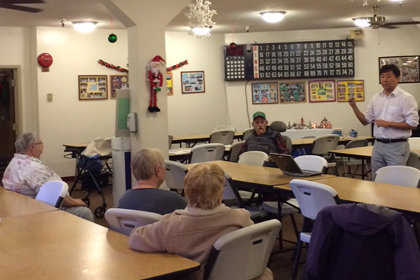Last summer, after graduating from the University of Vermont College of Medicine, Eric Chang, M.D.’15, saw first-hand how an elderly man struggling to care for his sick wife could get so tired and distracted that he would forgot to take his blood-pressure medication.

UVM College of Medicin alumnus Eric Chang, M.D.'15, teaches residents at Burlington, Vt.'s Heineberg Senior Center during his SASH fellowship. (Photo: Courtesy of UVM Center on Aging)
SASH Fellows program provides one-of-a-kind training for UVM medical students
Last summer, after graduating from the University of Vermont College of Medicine, Eric Chang, M.D.’15, saw first-hand how an elderly man struggling to care for his sick wife could get so tired and distracted that he would forgot to take his blood-pressure medication.
A geriatric fellowship through the University of Vermont Center on Aging gave Chang important insight into the social dynamics that influence a person’s health.
“When you go into people’s homes, you begin to understand why certain disease processes are more chronic,” says Chang, now an internal medicine resident at Morehouse School of Medicine in Atlanta, Ga.
He was one of two 2015 fellows working for Support and Services at Home (SASH), a state-funded program intended to further Vermont’s health care reform efforts by employing community-based care coordinators at low-income, nonprofit senior housing facilities. Coordinators and teams of nurses work for the buildings or residential complexes, many under the Vermont State Housing Authority, and oversee care, health education and activities for the Medicare-eligible participants who live there. Since 2009, five UVM College of Medicine students, as well as several UVM nursing students, have served as SASH fellows.
SASH recently received the 2016 Excellence in Program Innovation Award from the American Public Health Association (APHA) and the charitable Archstone Foundation. The award recognizes top initiatives in health and aging and includes an invitation for the winners to make a presentation at the APHA annual meeting, which takes place October 29 to November 2, 2016 in Denver, Colo.
The idea for SASH came from Nancy Eldridge, former executive director of the Cathedral Square senior-living community in South Burlington, Vt., where she observed ambulances coming and going for residents and saw the need for an alternative to give them care at home. Her concerns helped launch the Housing and Supportive Services (HASS) program, a precursor to SASH.
The earlier program also operated largely through the Housing Authority and involved on-site coordinators and nurses providing programs and care to seniors. HASS staff, though, had no clearance to discuss patients’ health needs with doctors or hospitals. SASH participants sign their approval to clear their caregivers for those communications, says Jeanne Hutchins, executive director of the UVM Center on Aging.
Each SASH site covers a “panel” of typically 100 residents, registered through Medicare. If a building has only 75 residents that qualify, the panel can expand to older adults living elsewhere in the community.
SASH launched with a pilot program at Heineberg Senior Housing in Burlington in 2009 and went statewide two years later. It now includes 54 panels.
The uniqueness of SASH is its arrangement through the housing system, rather than the health care system, Hutchins says. “This was unheard of before, putting services in housing by housers.”
SASH coordinators form close relationships with participants, getting to know the details of their lives and health issues. They check to make sure they’re eating right, taking their medication or getting flu shots – the kind of attention that a primary physician, pressed for time and seeing patients under duress, often can’t provide. This at-home coordinated care ideally leads to the improved health outcomes that the Vermont Blueprint for Health envisions.
A report released in June by research agency RTI International, which examined Medicare claims information, found that health care costs for SASH participants increased $1,536 less per year than they did for seniors living in affordable housing who were not involved in SASH.
Since its start, SASH has collected reams of health care data, showing the areas of greatest need for participants with issues such as diabetes or depression. Chang led presentations on those topics and others for SASH groups.
“There’s a limit to how much can be done from the medical side of things,” says Chang. “Medicine has to address the social side of things, too. I didn’t really appreciate that before I did the fellowship.”